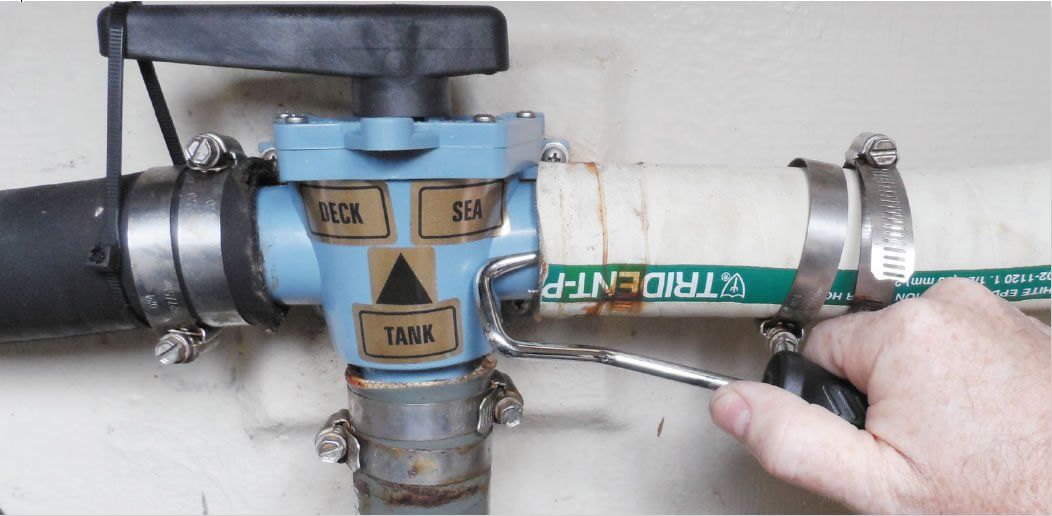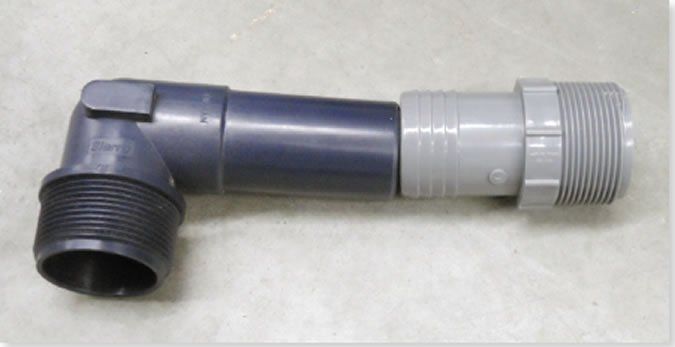Pulling hoses is generally low on the fun list. They are in bad places, jammed onto crusty hose-fitting barbs, and have stiffened over the years. As part of our 2016 update on long-term tests, we needed to wiggle loose a few of the sanitation hoses were testing to see how they were looking on the inside-a job much less pleasant than new installation.

Photos by Drew Frye
After flushing the hoses well with clean water and vinegar, testers donned rubber-coated gloves (for better grip) and firmly rocked the hoses. In most cases, this was enough to break the seal, but some hoses were too stubborn. Heat can soften hose for pulling or installing, but warming it too much can ruin it (never too hot to touch). Rather than resort to cutting the hose off in pieces-scarring the barb and inviting future leaks in the process-we sought the right tool for the job, which turned out to be neither marine, nor expensive.
OTC Hose Puller
There are several different types of hose-pulling tools. Some contain a knife-like edge and are intended to cut the hose off by slicing it from the end and the inside. These are not much use on wire-reinforced hose and typically are more destructive than useful. Many come only in sets, with hooks designed to access hoses from every possible angle.
The hose puller we found to be the most useful on marine sanitation hoses is OTC Tools Hose Removal Tool (4521), which is designed for the automotive industry. It is nothing more than a simple handle with an offset hook that allows you to reach up inside the hose (on that seacock you can barely reach), wiggle it around to break the seal, and gradually ease it off. Its not always that simple, but we were able to remove all of the hoses without damage to the hose or barb and to easily re-install the same hoses on the same fittings.
Proper Hose Fit
Before you start tugging away on your stuck hoses, there are a few things you should know. One of the leading causes of stuck hoses is incorrectly matched hose barbs. Most sanitation hoses-and other marine hoses-are actually metric, so ramming them onto barbed, U.S.-standard fittings is a sure recipe for a permanently stuck-on hose. The best bet for use with sanitation hose is using fittings that are smooth (no pressure) and double clamped; these are available from most sanitation-equipment suppliers.
Matching hose to fittings also is important to prevent leaks. Leaks not caused by poor fit are often the results of imperfection in or damage to the barbs, damage to the hose, or poor clamping. Remove the hose and inspect the barb. Can it be replaced if its defective, or can the defects be minimized by careful sculpting with a file? If the hose is damaged, can you trim a few inches? Is there debris in the clamping area? If single-clamped, add a second clamp so that its screw is opposing the first.
Are the clamps properly positioned, both over the barb? Weve seen plenty of hoses that were missing the second clamp, or the barb was missing. Weve also seen hoses positioned so that the barb was cutting the hose like scissors. The wrong solution in this case is to simply add caulk as a sealant; it doesn’t address the problems, nearly always fails, and complicates proper repair.
Finally, a lubricant helps the hose slide into proper position on the barb rather than getting stuck only half way on. But don’t simply reach for a dollop of grease. Petroleum products can shorten the life of the hose, and as we all know, sanitary hose is hard to replace. Many marine hoses, specifically those using either butyl or EPDM liners, are incompatible with petroleum products. Vinyl hose becomes hardened when exposed to petroleum products. Instead, either research the manufacturers recommendation or use a glycerin-based lubricant as a safe, all-purpose hose lube. It is fully compatible with all materials, slippery, easy to clean up, and over time, it will evaporate away, encouraging a leak-free connection.
Bottom line: Most hose leaks, premature failures, and hose removal problems stem from installation errors. Close attention to detail will insure long-life and simple maintenance. But if you have stubborn, stuck-on hoses, the OTC 4521 hose removal tool is well worth the $9 price tag, even if you need it only once.





































For water or coolant hoses that need to be easily removed I have switched to silicon radiator hose. I’ve had no problems with years of use. Be sure to use a smooth hose clamp to prevent cutting into the hose. If the engine hasn’t been used in a long time I remove the hose to the raw water pump and add a little soapy water to prime and lubricate it to extend the life of the impeller. It is very easy with the silicon hose.
When I need to remove a vinyl hose, to heat all around the fitting without overheating one side or the stuff around it, I wrap a strip of towel around the connection and soak it in hot water. I refresh the hot water several times and it softens the hose without overheating.